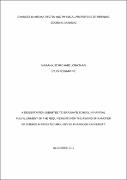| dc.contributor.author | Namakajjo, Richard Jonathan | |
| dc.date.accessioned | 2022-02-16T11:30:16Z | |
| dc.date.available | 2022-02-16T11:30:16Z | |
| dc.date.issued | 2019-11 | |
| dc.identifier.citation | Namakajjo, Richard Jonathan (2019) Changes in aroma, pectin and physical properties of ripening cooking Bananas | en_US |
| dc.identifier.uri | https://kyuspace.kyu.ac.ug/xmlui/handle/20.500.12504/584 | |
| dc.description | xii,104 p.: ill (somecol) | en_US |
| dc.description.abstract | Post-harvest losses are high in the cooking banana value chain in Uganda due to the short shelf life of the green bananas (6 to 10 days). The losses give rise to large amounts of solid wastes that later decompose into greenhouse gases that contribute to global warming. Hence, there is a need to add value to waste bananas by extracting bioactive substances such as aroma and pectin. In this study, changes in pulp and peel Colour, texture, fruit, pulp and peel weight, fruit, pulp and peel thickness and specific gravity were analysed during 0-12 days of ripening under ambient conditions. Pectin content was determined using acid extraction in combination with either ethanol or calcium chloride precipitation methods. Chemical properties of the pectin (ash content, methoxyl content, anhydrouronic acid and degree of esterification) were analyzed using Rangana’s protocol.
Aroma compounds in the three ripening cooking banana cultivars, Nakitembe AAA-EA (NAK), Mpologoma AAA-EA (MPO) and Musakala AAA-EA (MUS) were analyzed using solid phase micro-extraction with gas chromatography flame ionization detection (SPME-GC-FID). Pectin extracted from the banana samples was used to formulate a pineapple jam containing different concentrations of banana pectin. The jam was evaluated for sensory acceptability using 30 untrained panelists.
Colour significantly (p<0.05) changed from green to yellow in all cultivars with the peel showing more observable changes compared to pulp. There was significant decrease in hardness of all the selected bananas cultivars (p<0.05); Nakitembe 84.51 N to 9.76 N (88.45 % reduction), Musakala 80.48 N to 11.0 N (86.33 % reduction), Mpologoma 76.81 to 13.46 (82.48 % reduction). During the ripening period, hardness, fruit and peel weight, as well as fruit and peel thickness decreased significantly (p<0.05) and the extent of decrease was specific to a given banana cultivar. There was a significant increase in pulp to peel ratio for | en_US |
| dc.language.iso | en | en_US |
| dc.publisher | Kyambogo University | en_US |
| dc.subject | Changes in aroma, pectin. | en_US |
| dc.subject | Physical properties. | en_US |
| dc.subject | Ripening cooking bananas. | en_US |
| dc.title | Changes in aroma, pectin and physical properties of ripening cooking bananas | en_US |
| dc.type | Thesis | en_US |

